Effect of Solid Volume Concentration on the Rheological Properties of Debris Flow: A Case Study of Jiangjiagou Debris Flow in China
Abstract
:1. Introduction
2. Materials and Methods
2.1. Experimental Materials
2.2. Sample Preparation
2.3. Experimental Method
3. Experimental Results and Analysis
3.1. Rheological Curves at Different Volume Concentrations
3.2. The Influence of Volume Concentration on the Rheological Parameters of the Debris Flow
3.3. Shear-Thinning Behavior Characterization
3.4. The Effects of Solid Volume Concentration on the Rheological Behavior of Debris Flows
4. Conclusions
- (1)
- The rheological curves of the debris flow from Jiangjiagou generally conformed to the Bingham fluid model, where shear stress consistently increases linearly with shear rate. The elevation in solid volume concentration continuously increased the rheological curves’ upward trend; yet, the increase in shear stress was not particularly significant at low volume concentrations and became more pronounced only at high volume concentration.
- (2)
- In a semi-log coordinate system, both the yield stress and the viscosity of the debris flow from Jiangjiagou exhibited a linear relationship with the solid volume concentration, which formed the basis for establishing a predictive formula for the rheological parameters of the debris flow in relation to the solid volume concentration.
- (3)
- The increase in solid volume concentration led to a higher solid phase volume fraction in the debris flow, resulting in reduced water content, increased viscosity, inhibited turbulence in the debris flow, a tighter structure, mutual adhesion of coarse and fine particles, greater friction between particle contacts, and hence, a continuous increase in resistance.
- (4)
- Typical clay minerals with high content exhibit superior properties in specific surface area, hydrophilicity, expansibility, and surface adsorption capability compared to atypical clay minerals, thereby endowing the debris flow slurry under high volume concentration conditions with strong capture ability of pore water, resulting in a debris flow with strong fluidity and viscosity.
- (5)
- The debris flow exhibited a significant shear-thinning effect, which was more pronounced at lower shear rates, greatly reducing the viscous resistance of the debris flow.
Author Contributions
Funding
Institutional Review Board Statement
Informed Consent Statement
Data Availability Statement
Conflicts of Interest
References
- Iverson, R.M. Scaling and design of landslide and debris-flow experiments. Geomorphology 2015, 244, 9–20. [Google Scholar] [CrossRef]
- Iverson, R.M. The physics of debris flows. Rev. Geophys. 1997, 35, 245–296. [Google Scholar] [CrossRef]
- Zhao, Y.; Meng, X.; Qi, T.; Chen, G.; Li, Y.; Yue, D.; Qing, F. Estimating the daily rainfall thresholds of regional debris flows in the Bailong River Basin, China. Bull. Eng. Geol. Environ. 2023, 82, 46. [Google Scholar] [CrossRef]
- Julien, P.Y.; Paris, A. Mean velocity of mudflows and debris flows. J. Hydraul. Eng. 2010, 136, 676–679. [Google Scholar] [CrossRef]
- Zhou, Z.H.; Ren, Z.; Wang, K.; Yang, K.; Tang, Y.J.; Tian, L.; Xu, Z.M. Effect of excess pore pressure on the long runout of debris flows over low gradient channels: A case study of the Dongyuege debris flow in Nu River, China. Geomorphology 2018, 308, 40–53. [Google Scholar] [CrossRef]
- Neely, A.B.; DiBiase, R.A. Sediment controls on the transition from debris flow to fluvial channels in steep mountain ranges. Earth Surf. Process. Landf. 2023, 48, 1342–1361. [Google Scholar] [CrossRef]
- Li, Y.; Zhou, X.; Su, P.; Kong, Y.; Liu, J. A scaling distribution for grain composition of debris flow. Geomorphology 2013, 192, 30–42. [Google Scholar] [CrossRef]
- Yang, T.; Li, Y.; Zhang, Q.; Jiang, Y. Calculating debris flow density based on grain-size distribution. Landslides 2019, 16, 515–522. [Google Scholar] [CrossRef]
- Kaitna, R.; Palucis, M.C.; Yohannes, B.; Hill, K.M.; Dietrich, W.E. Effects of coarse grain size distribution and fine particle content on pore fluid pressure and shear behavior in experimental debris flows. J. Geophys. Res. Earth Surf. 2016, 121, 415–441. [Google Scholar] [CrossRef]
- Tsunetaka, H.; Hotta, N.; Sakai, Y.; Wasklewicz, T. The effect of debris-flow sediment grain size distribution on fan forming processes. Earth Surf. Dyn. Discuss 2021, 69, 1–20. [Google Scholar] [CrossRef]
- Coussot, P.; Laigle, D.; Arattano, M.; Deganutti, A.; Marchi, L. Direct determination of rheological characteristics of debris flow. J. Hydraul. Eng. 1998, 124, 865–868. [Google Scholar] [CrossRef]
- Jan, C.D.; Yang, C.Y.; Hsu, C.K.; Dey, L. Correlation between the slump parameters and rheological parameters of debris-flow. Assoc. Environ. Eng. Geol. Spec. Publ. 2019, 28, 323–329. [Google Scholar] [CrossRef]
- Hübl, J.; Steinwendtner, H. Estimation of rheological properties of viscous debris flow using a belt conveyor. Phys. Chem. Earth Part B Hydrol. Ocean. Atmos. 2000, 25, 751–755. [Google Scholar] [CrossRef]
- Takahashi, T. Mechanical characteristics of debris flow. J. Hydraul. Div. 1978, 104, 1153–1169. [Google Scholar] [CrossRef]
- Bagnold, R.A. Experiments on a gravity-free dispersion of large solid spheres in a Newtonian fluid under shear. Proceedings of the Royal Society of London. Ser. A Math. Phys. Sci. 1954, 225, 49–63. [Google Scholar] [CrossRef]
- Wang, Y.; Zhan, Q.; Li, C.; Han, W. Preliminary Experiment to Rheological Characters of Viscous Debris flowe, Jiangjia Ravine Yunnan, China. J. Mt. Sci. 2002, 1, 42–46. (In Chinese) [Google Scholar]
- Yang, H.J.; Wei, F.Q.; Hu, K.H. Rheological parameters of debris flow slurries with different maximum grain sizes. J. Hydraul. Eng. 2016, 47, 884–890. (In Chinese) [Google Scholar]
- Sosio, R.; Crosta, G.B. Rheology of concentrated granular suspensions and possible implications for debris flow modeling. Water Resour. Res. 2009, 45, 1–16. [Google Scholar] [CrossRef]
- Yang, T. Granular effect on debris flow rheology. In Proceedings of the EGU General Assembly Conference Abstracts (EGUGA), Online, 19–30 April 2021. [Google Scholar] [CrossRef]
- Zhang, S. A comprehensive approach to the observation and prevention of debris flows in China. Nat. Hazards 1993, 7, 1–23. [Google Scholar] [CrossRef]
- GB/T 50123-2019; Ministry of Water Resources, People’s Republic of China. Geotechnical Test Method Standard GB/T 50123-2019. China Planning Press: Beijing, China, 2019. (In Chinese)
- Schippa, L.; Doghieri, F.; Pellegrino, A.M.; Pavesi, E. Thixotropic behavior of reconstituted debris-flow mixture. Water 2021, 13, 153. [Google Scholar] [CrossRef]
- Mambretti, S.; Larcan, E.; De Wrachien, D. Theoretical and experimental analysis of debris flow: Rheology and two-phase modelling. Irrig. Drain. J. Int. Comm. Irrig. Drain. 2008, 57, 555–570. [Google Scholar] [CrossRef]
- Yu, B.; Ma, Y.; Qi, X. Experimental study on the influence of clay minerals on the yield stress of debris flows. J. Hydraul. Eng. 2013, 139, 364–373. [Google Scholar] [CrossRef]
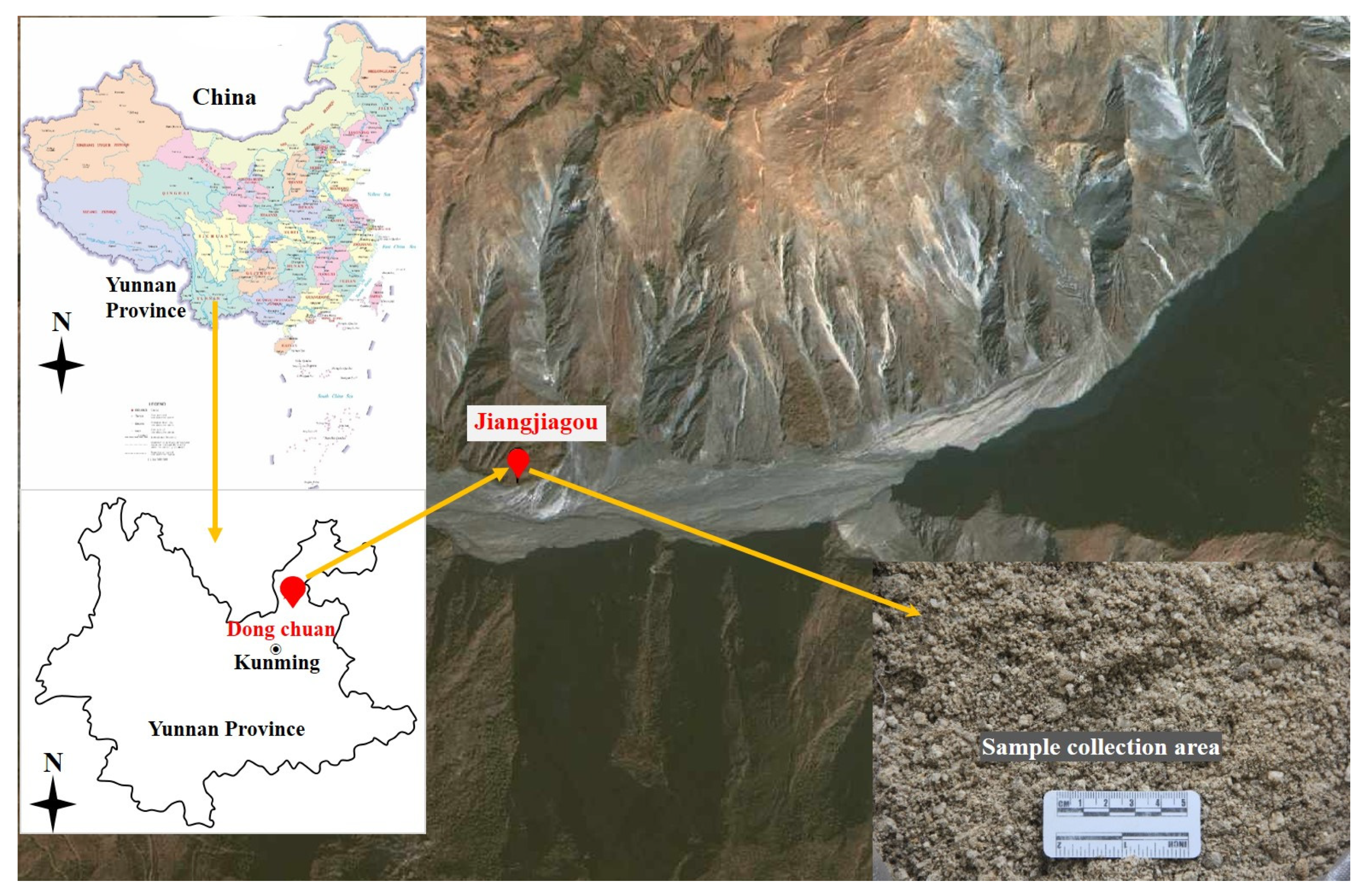
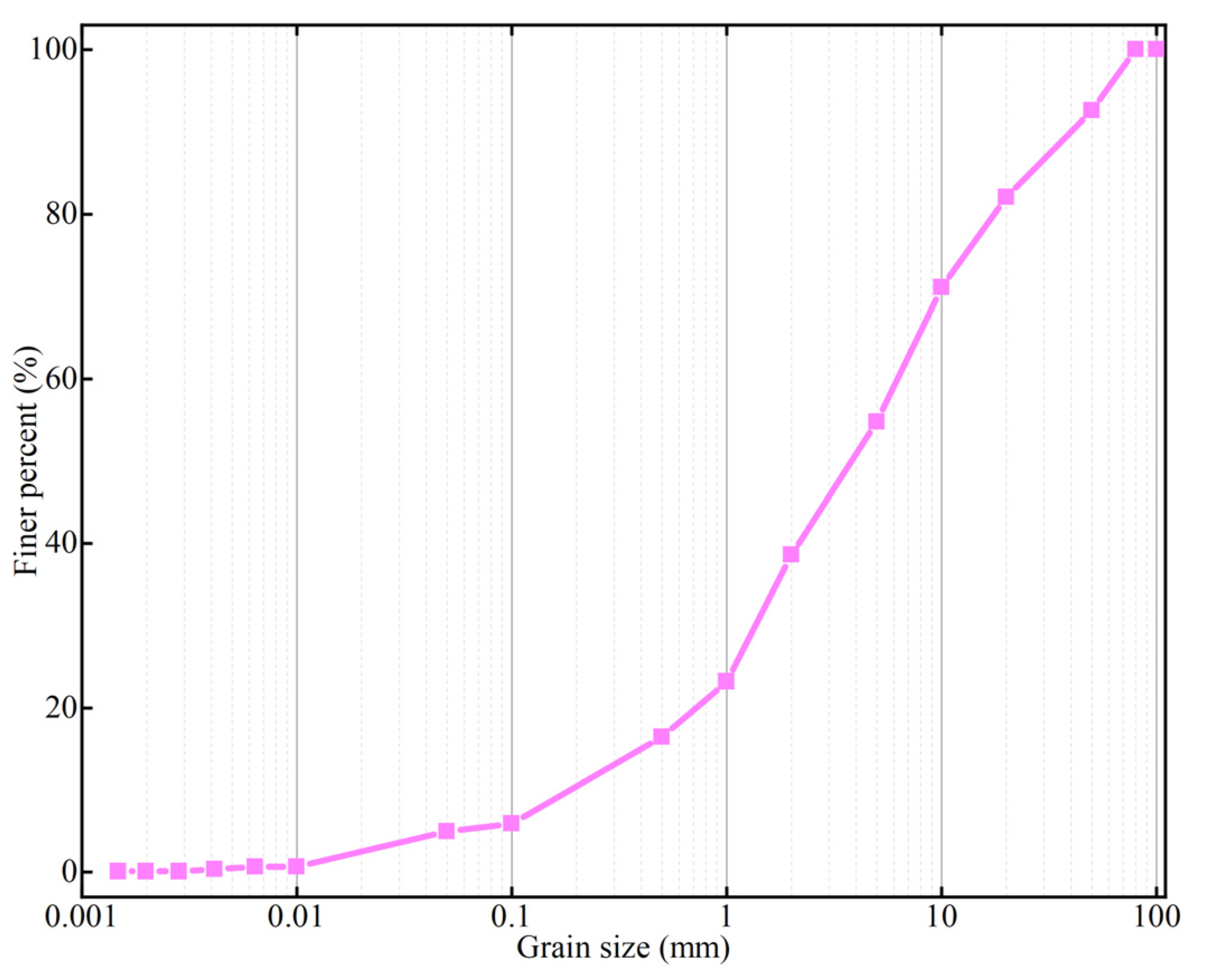
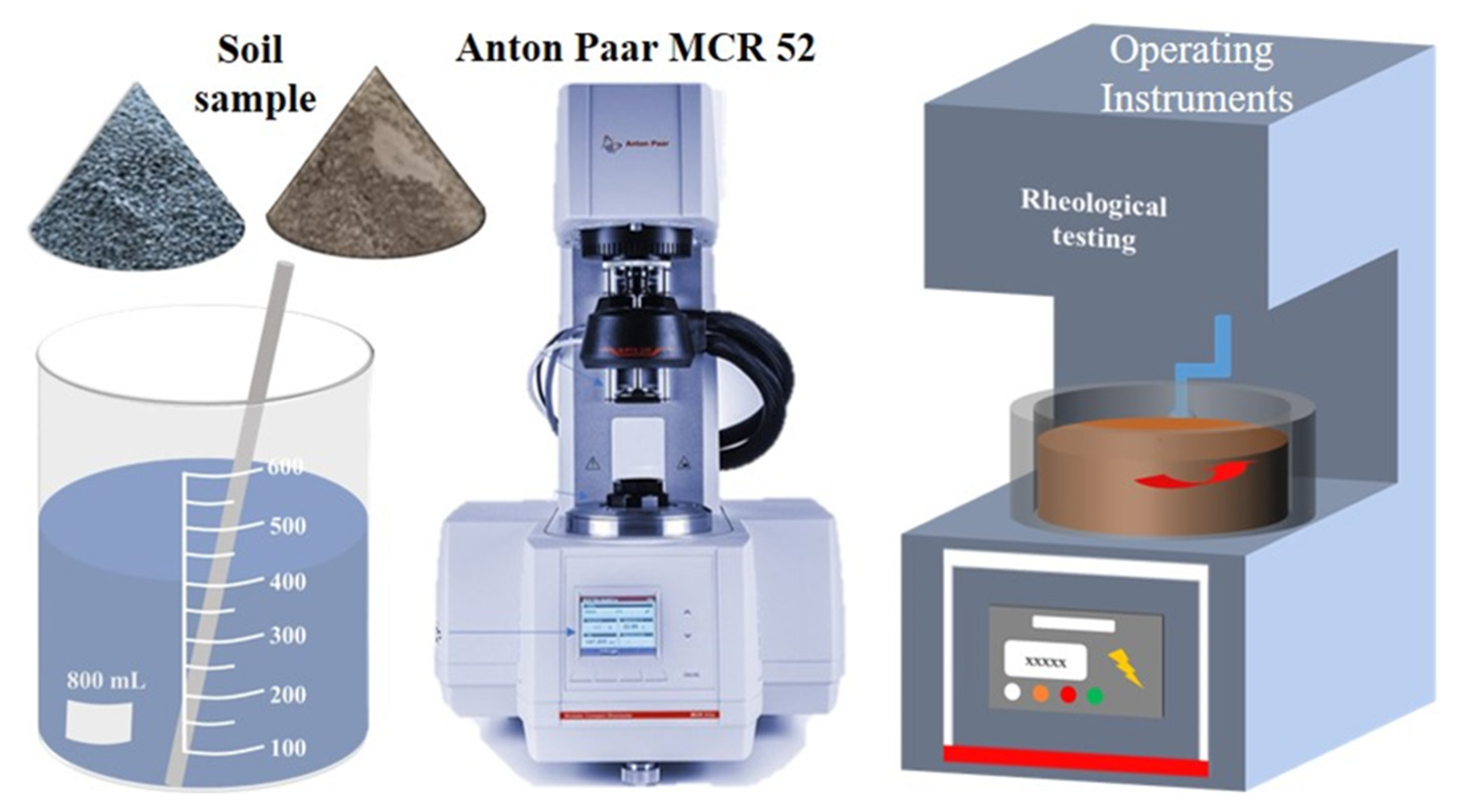
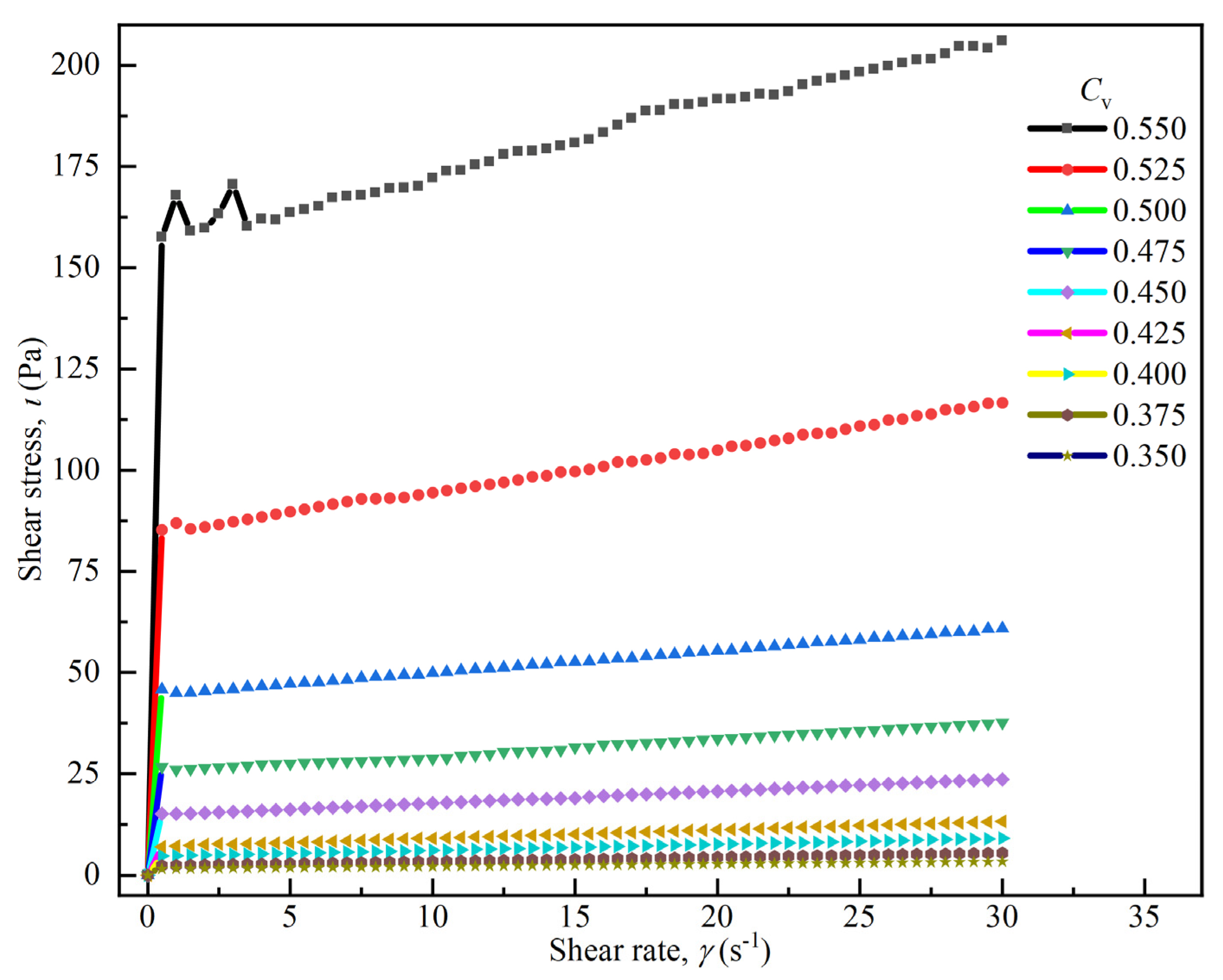

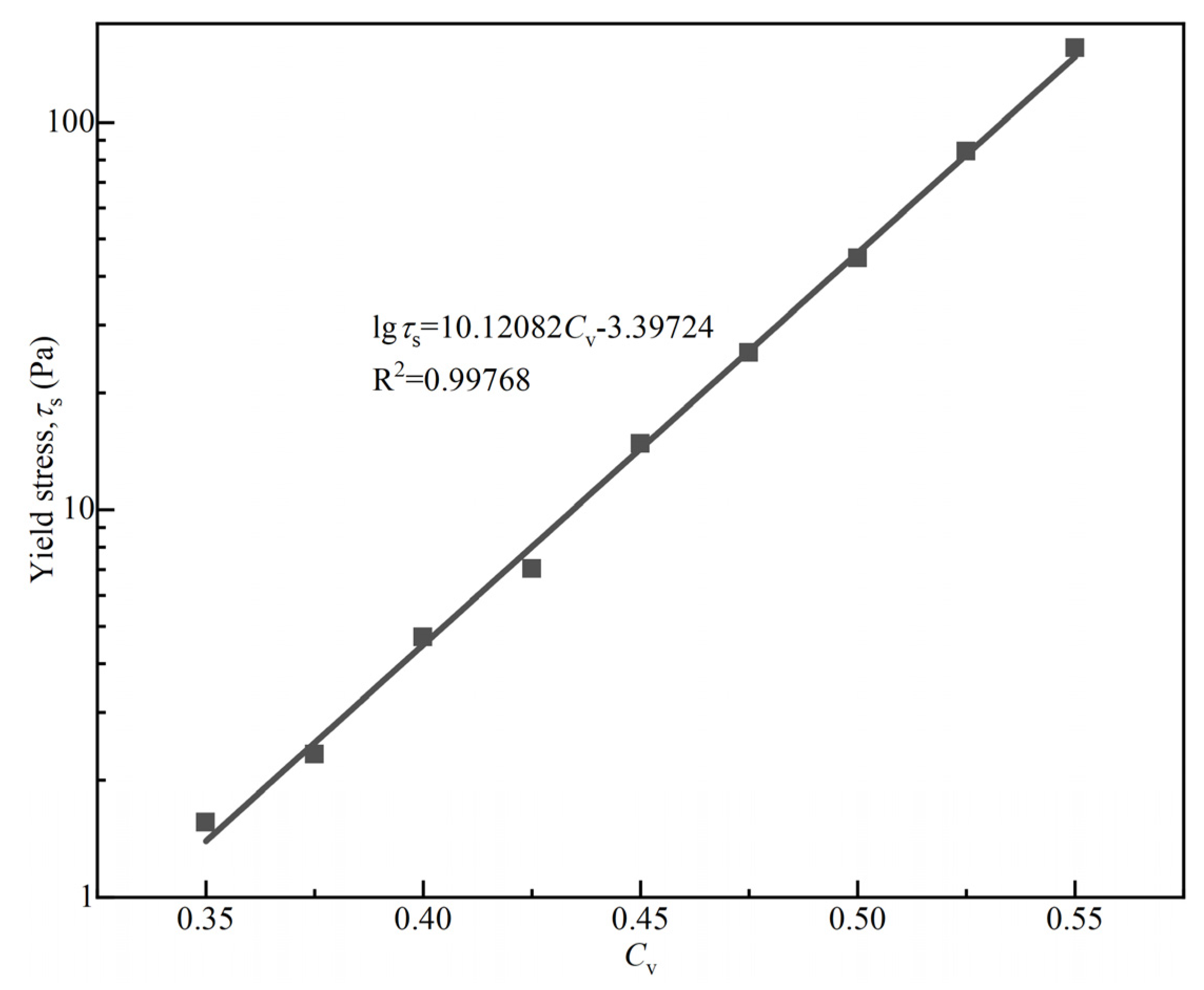
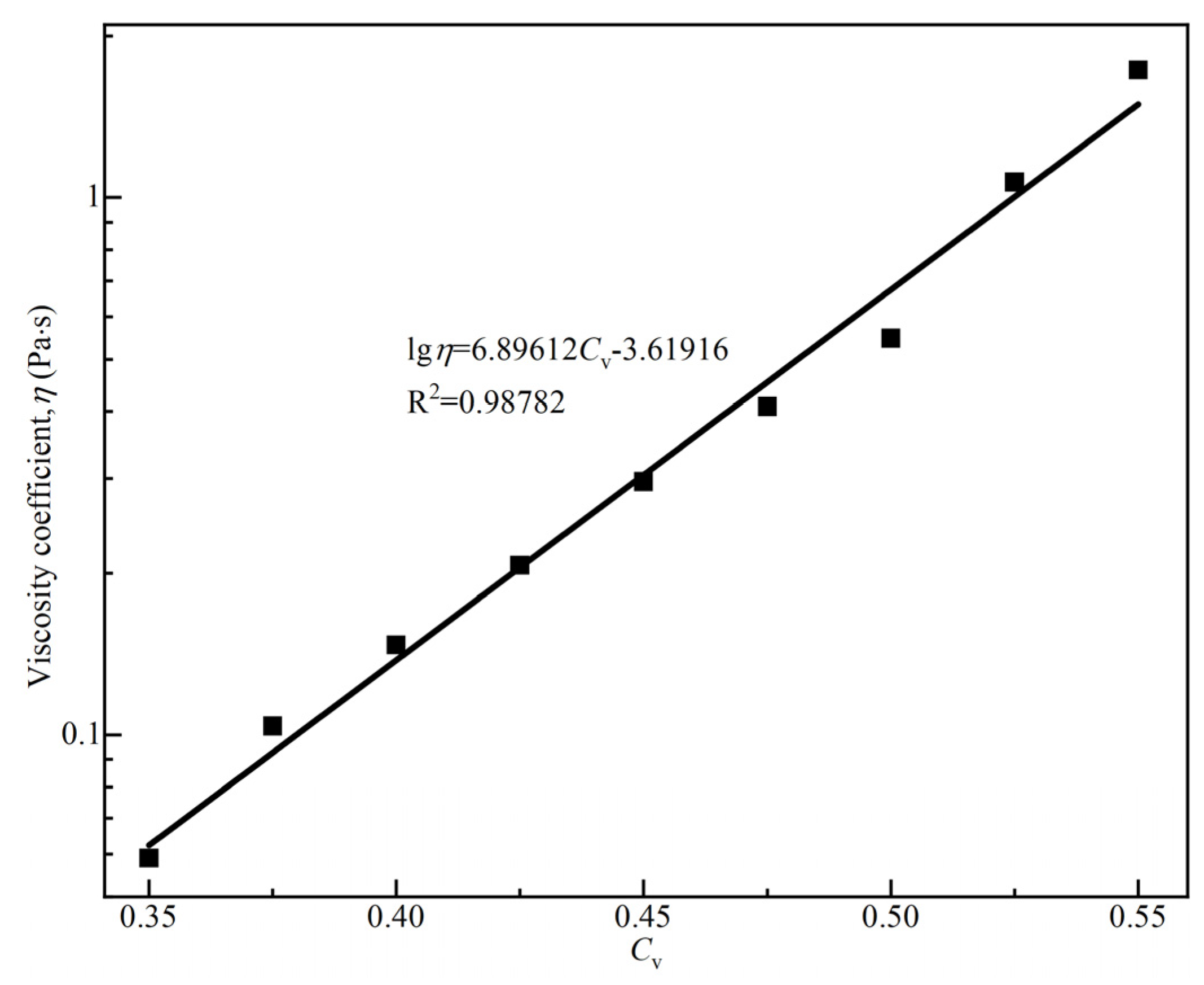
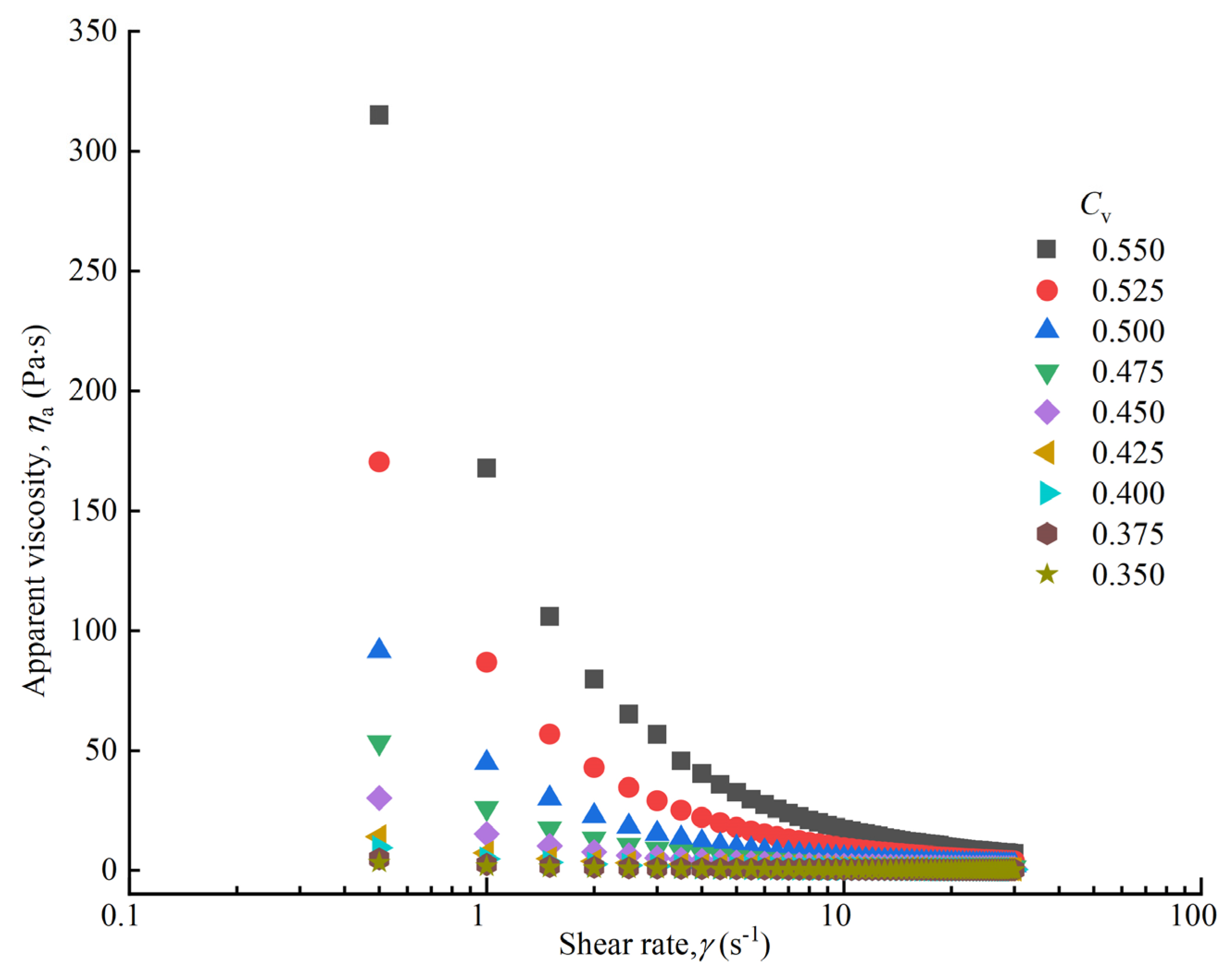

| Minerals | Quartz | Illite | Plagioclase | Chlorite | Potassium Feldspar |
| Content (%) | 4.4 | 57 | 4.3 | 31.6 | 2.7 |
| Granular Parameters | d60 | d30 | d10 | d50 | Cu | Cc |
| Particle Size (mm) | 6.682 | 1.196 | 0.238 | 3.795 | 28.076 | 0.899 |
| Cv | 0.350 | 0.375 | 0.400 | 0.425 | 0.450 | 0.475 | 0.500 | 0.525 | 0.550 |
| τs (Pa) | 1.5579 | 2.3315 | 4.6737 | 7.0227 | 14.767 | 25.376 | 44.452 | 84.125 | 155.34 |
| η (Pa·s) | 0.0589 | 0.1039 | 0.1471 | 0.2068 | 0.2959 | 0.4081 | 0.5475 | 1.0686 | 1.7291 |
| R2 | 0.9997 | 0.9980 | 0.9998 | 0.9995 | 0.9976 | 0.9931 | 0.9987 | 0.9975 | 0.9934 |
| Cv | 0.350 | 0.375 | 0.400 | 0.425 | 0.450 | 0.475 | 0.500 | 0.525 | 0.550 |
| a | 0.14058 | 0.31336 | 0.6224 | 0.80036 | 1.13374 | 1.3773 | 1.6229 | 1.89992 | 2.17517 |
| b | −0.7746 | −0.7486 | −0.8027 | −0.8117 | −0.8614 | −0.8875 | −0.9079 | −0.9059 | −0.9211 |
| R2 | 0.98838 | 0.98507 | 0.99095 | 0.99200 | 0.99529 | 0.99584 | 0.99785 | 0.99768 | 0.99796 |
Disclaimer/Publisher’s Note: The statements, opinions and data contained in all publications are solely those of the individual author(s) and contributor(s) and not of MDPI and/or the editor(s). MDPI and/or the editor(s) disclaim responsibility for any injury to people or property resulting from any ideas, methods, instructions or products referred to in the content. |
© 2024 by the authors. Licensee MDPI, Basel, Switzerland. This article is an open access article distributed under the terms and conditions of the Creative Commons Attribution (CC BY) license (https://creativecommons.org/licenses/by/4.0/).
Share and Cite
Wu, C.; Wei, J.; Hou, X. Effect of Solid Volume Concentration on the Rheological Properties of Debris Flow: A Case Study of Jiangjiagou Debris Flow in China. Appl. Sci. 2024, 14, 1940. https://doi.org/10.3390/app14051940
Wu C, Wei J, Hou X. Effect of Solid Volume Concentration on the Rheological Properties of Debris Flow: A Case Study of Jiangjiagou Debris Flow in China. Applied Sciences. 2024; 14(5):1940. https://doi.org/10.3390/app14051940
Chicago/Turabian StyleWu, Chaoyang, Jiaojiao Wei, and Xiaoqiang Hou. 2024. "Effect of Solid Volume Concentration on the Rheological Properties of Debris Flow: A Case Study of Jiangjiagou Debris Flow in China" Applied Sciences 14, no. 5: 1940. https://doi.org/10.3390/app14051940





